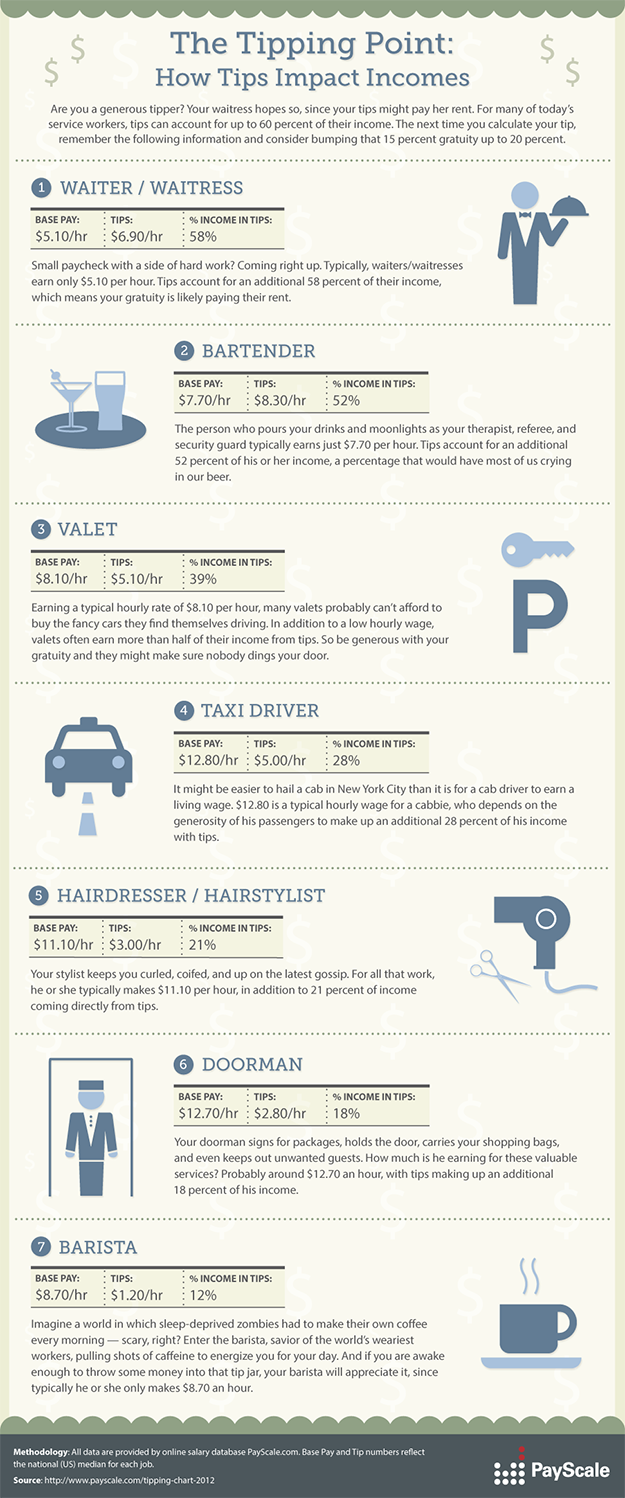In the hospitality industry, managing the tipping structure is one of the more intricate aspects. For restaurants and hotels, it is crucial to effectively administer and distribute tips among staff members. Often, tips constitute a significant portion of a server's income and play a vital role in motivating their performance. There are two options when it comes to dividing tips among the staff: keeping your tips, or pooling your tips (i.e. every man for themselves, or team work). Both have their pros and cons, but here we’re going to look at why you should pool tips.
In your establishment, if you decide to pool tips, everyone in your staff contributing to the pool must agree on how those tips are divided. As a an owner or a manager, you can provide some options for your servers to agree upon, but you can’t decide for them. Per a 2012 wagepoint study, tipping makes up to 60% of a tipped employees wages, so these decisions matter to your employees, and can be a major source of stress for some when not not managed properly.

With all that said, here are some possible options are splitting on a Percentage Basis, Point Basis, and Hourly Basis.
Why Should you tip pool?
Creating a culture where restaurant tip pooling is the norm can bring some great benefits to your business. The standard guest dining experience can be streamlined with a group dynamic and equal team contribution. For example: one waitperson is deep in the weeds, and another waitperson’s section is quickly clearing out, or the bar has been empty and not many drinks are flowing that evening. That person’s section could be neglected while everyone else stands around. With tip pooling, the other staff members who are less busy have the motivation to step in and run food or take an order to better those guest experience and provide a higher quality of service, thus earning a greater tip for the entire team.
Having a team focused restaurant culture can improve efficiency. When you operate as a team, everyone has a job, but that isn’t to say that is the only job they will or should do that shift. If you need to turn a table for a guest in the lobby, it should be all hands on deck. Just because you aren’t the bus person or that isn’t your designated “job” doesn’t mean you shouldn’t help. Knowing that your staff will all make more money by seating more guests should provide the motivation to help out wherever it’s necessary.
Tip pooling holds your staff accountable. Your restaurant can have the best food in the world, but if the guest dining experience is ruined by poor service, it won’t matter. The only thing they will remember is how Johnny took 15 minutes to take their order or how their $30 steak is now cold and “overpriced” because it died on the pass waiting to be run. Having accountable staff and a team-focused culture will make it very hard for that instance to happen.
If your establishment decides to tip pool, creating a streamlined process distributing tips is necessary. Having the staff do the paperwork at the end of the night is one less thing the manager needs to worry about, but can create some ambiguity among the waitstaff. The best way to combat that is with transparency and a decisive standard operating procedure. Whether the manager or staff fill out the tip pool “sheet” at the end of the night, here are three possible guides:
Percentage basis
Potentially the easiest way to distribute tips is by a percentage basis. Every staff position in the Front of the House excluding the manager or matrie’d has a percentage associated with the position. In many restaurants, this is the easiest way to distribute tips. It is fairly easy to understand and straight forward for whomever is doing the calculations. For example, say a typical restaurant that is open from 3-10 every day has 4 waitstaff, 2 bartenders, and 2 bussers. A typical distribution could be: 18% to Bar, 24% to Bus, and the remaining 58% goes to Waitstaff. This is, however, dependent on the duties of each person, but for this example let’s say this is a fair service distribution. On an average night, we assume $1,500 is collected in credit card tips. If additional cash tips are collected, they should be appropriated in the same manor. Breaking those numbers down it looks as such:
Check out the percentage basis spreadsheet here!
Point Basis
Similar to the percentage basis, each staff member is assigned a number of points. In an instance when senior or experienced staff are to be compensated differently, the point system is sound option for splitting tips. It is worth noting that splitting tips unevenly has many sticking points, it is a reality in some places who choose to not compensate veteran waiters in their hourly minimum wage. Using the same assumption: we have 4 waiters, 2 bus, and 2 bar. Below we will look at a instance where the servers have different point amounts based on experience/duties/etc. Again, assuming that at the end of the shift there is $1,500 collected in CC tips, you add up all of the points from each member of the front of the house staff, and divide that into the total amount of tips. For example: $1,500/70= $21.42 (always round down and kick the difference to the smallest subset (bar/bus.) That dollar amount is what each point is worth. That ends up looking like:
Check out the points basis spreadsheet here!
Hourly
When tip pooling has already been instituted, but the hours worked by an employee change or the duty changes part way through the shift, or whenever something doesn’t go perfectly, tipping out on the hourly basis may be the right way to go. This does not necessarily fit the mold of every restaurant, it largely depends on the style (quick service vs. fast casual vs. full service) and set up of the establishment. If hourly tipping is a good fit, it alleviates the common complaints that:
“Sally came 2 hours later than me, and didn’t do any side work, she doesn’t deserve the same amount of money as I do” or the “Can I leave early? I have to go juggle knifes and walking across a flaming fire pit at the music festival in town.”
If everyone contributes for the same amount of time, it is assumed everyone feels it is fair to split the money evenly. What happens when you are expecting a really crazy dinner rush and have a server come in just for the rush? What happens when you have a staff member that has to wait to come in because of a childcare situation? Both are common occurrences where tipping on a straight percentage or point basis becomes messy, complicated and possibly unfair.
This works as a combination of the percentage and point basis methods. Each role (wait, bus, bar) is assigned a percentage. You multiply that percentage by the total tips and that is how much each position has to split. You then take every employee who worked that day, and add up the total hours worked. Taking the total tips of each position, you divide the total number of hours worked into that number to get the entire staffs hourly rate. See below for an example:
(credit M.E.)
Get your hands on the hourly basis spreadsheet here!
In the above example, the bar gets 10%,the busser gets 20%, and the waitstaff gets 70%. This example only has 1 bar tender in it. You input the total tips, the hours worked by everyone, and it spits out how many hours each person worked, what the hourly rate is for each type of employee, and what their split of the total should be based on that hourly rate.
So that’s it! Three options for pooling tips. When presenting your team with these options, make sure to explain the pro’s and con’s of each method, and be honest and open with your team. Once you have your chosen method, consider switching to a Point-of-sale like Upserve that will calculate the pool for you,

